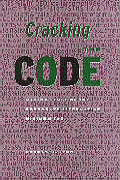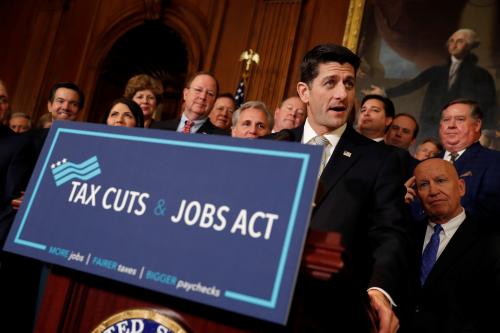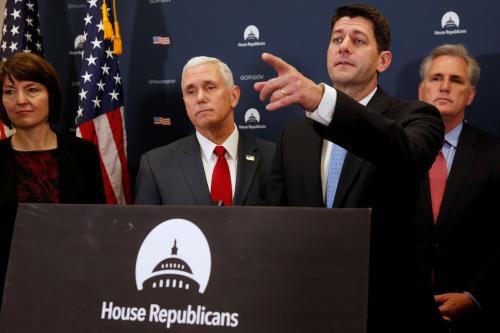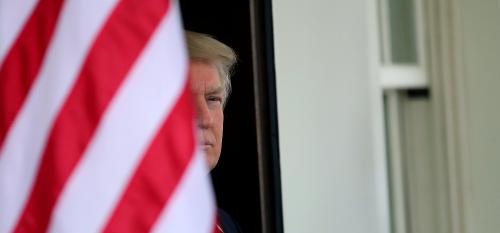This article originally appeared on The Hill on February 22, 2017.
House Republicans, led by Rep. Paul Ryan (R-Wis.) and Rep. Kevin Brady (R-Texas), want to replace the corporate income tax with a destination-based cash flow tax (DBCFT). They also want to reduce the tax from its current 35 percent down to 20 percent for corporations and 25 percent for other businesses, such as sole proprietorships and partnerships.
Here’s a better idea — let’s replace the creaky old corporate income tax with the shiny, new, DBCFT, but don’t cut the rate.
Almost everyone agrees that the current corporate income tax hurts the economy. By barring firms from immediately deducting the full costs of investment, the tax discourages capital investment, which in turn reduces the productivity and wages of American workers. By allowing companies to deduct interest but not dividend payments, the tax encourages firms to take on too much debt instead of raising equity.
By taxing worldwide income but allowing taxes on foreign income to be deferred until the funds are repatriated, the corporate income tax gives firms incentives to move production, income, and headquarters out of the country. All told, the corporate income tax has more harmful effects on economic growth than income, payroll, or consumption taxes, according to the OECD.
Reducing the corporate income tax rate would reduce the severity of all of these problems, so why not reduce the tax rate under the DBCFT? Because the great virtue of a well-designed destination-based cash-flow tax — the reason for considering it in the first place — is precisely that it would avoid the problems created by the current corporate tax.
The DBCFT would tax sales of goods and services, net of production costs, including all employee compensation and the full cost of new investments. Unlike the current corporate income tax, which only allows capital investments to be deducted over several years, the DBCFT would not tax or reduce U.S. capital investment, production, or wages.
Unlike the corporate tax, the DBCFT would not subsidize excessive borrowing. Nor would it encourage businesses to move profitable activities, reported profits, or headquarters abroad.
These are wonderful attributes for a DBFCT. But they are also exactly why we don’t need to cut the rate in a DBCFT. The cash-flow tax does not create the problems the corporate income tax does, we do not need lower rates to address those problems. Changing to a DBCFT would already address the problems.
Let’s replace the creaky old corporate income tax with the shiny, new, [destination-based cash flow tax], but don’t cut the rate.
In fact, setting the cash-flow rate at 35 percent, rather than the 20 or 25 percent proposed by the House Republicans, has several advantages. If the business rate were 25 percent or less, there’d be a big gap between the top individual income tax rate and the business tax rate, which would give taxpayers incentives to re-label wages as business income as a way to cut taxes. The lower business rate would give big, inefficient, and unfair windfall gains to the current returns from old investments.
Perhaps most importantly, keeping the rate at 35 percent, rather than cutting it, would raise significantly more revenue, which would help address our well-known long-term fiscal shortfall. The business tax provisions in the House Republican plan would lose almost $900 billion in revenue over the next 10 years.
The overall plan would lose $2 to $3 trillion. Keeping the DBCFT rate at 35 percent would make a serious dent in those revenue losses. Indeed, the beauty of a DBCFT is precisely that it could raise substantial revenue without creating the economic distortions and inefficiencies that the corporate tax does.
Some might object that a 35 percent tax rate would make the border adjustment — the tax on imports and the exemption of exports, which is part of the DBCFT — harder to handle. But it is already clear that the DBCFT, at any rate, would need to come with transitional relief for importers. So, having a 35 percent rate rather than 25 percent or less would just slightly extend the transition period.
Of course, there are other major issues and hurdles facing the cash-flow tax that would need to be addressed before implementation. Still, the DBCFT solves many problems that the corporate income tax creates. This is both the reason for considering it and the reason why we do not have to lower the tax rate in a cash-flow tax to achieve favorable economic outcomes.
The Brookings Institution is committed to quality, independence, and impact.
We are supported by a diverse array of funders. In line with our values and policies, each Brookings publication represents the sole views of its author(s).










Commentary
Op-edThe House GOP tax plan needs some tweaking
February 24, 2017